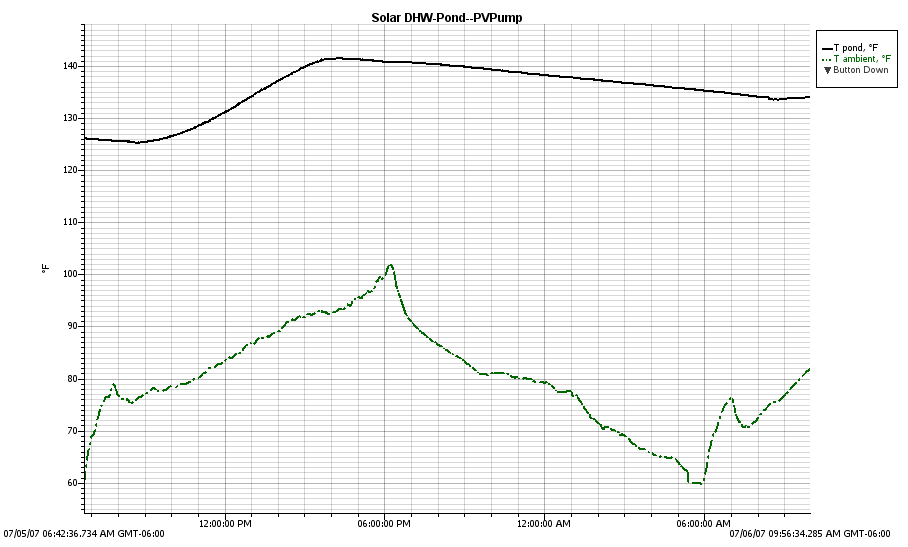
Search
The Renewable Energy site for Do-It-Yourselfers
Solar Pond Domestic Water Heater --
Performance
One day (and night) performance for
prototype 3 of the solar pond domestic water
heater.

Temperature of pond water -- Black
solid line
Ambient temperature -- Green dash-dot
line
Temperature at pump outlet to
absorber - Blue dashed line
Temperature at return from absorber
to pond - Red solid line
Test Date: 7/6/07 -- mostly
sunny
The plot shows the pond temperatures
for the day and night of 7/5/07 into the morning of 7/7/07.
Day Period:
7/6/07 -- 9am to 4pm - daytime
collection under sunny conditions:
The 191 gallons of water in the pond
is heated by water that is pumped out onto the surface of the absorber by the PV
panel powered pump. The pond temperature goes up from 125.5F to 141.25F --
as rise of 16.25F. The net heat addition for the day is (16.25F)(191
gal)(8.3 lb/gal)(1 BTU/lb-F) = 25760 BTU.
The mid day gain per hour is about
3.02F/hr, or 4793 BTU/hr, or 4793/29 sf = 165 BTU/sf of absorber. If you
assume 316 BTU/sf-hr (1000 w/m^2) sun, then the efficiency is in the order of
165/216 = 52%.
This does not show in the plot, but
the temperature rise from the pump outlet and the temperature of the water
returning from the pond is quite small, indicating that the flow is sufficient
to keep the temperature rise over the absorber small, and the losses low.
Night Period:
4pm to 9am of 7/7/07 -- night
time heat loss period.
Overnight, the tank cools from
141.25F down to 133.5F -- a drop of 7.7F.
This is a loss of (7.7F)(191 gal)(8.3
lb/gal) = 12200 BTU, or 12200/16.5 hrs = 739 BTU/hr
The tank is insulated with 2 inches
of polyiso insulation plus the a 1.5 inch wood frame and an outer air film.
This should be good for about R15.
But, the 739 BTU/hr overnight drop
implies
Q = A dT/R, or R = A dT/Q = (76 ft^2)(138.2F - 79.2F)/(739 BTU/hr) = R6
where A is the surface area of the
tank of 76 sf, 79.2F is average ambient, 138.2F is average tank temp.
So, the actual losses imply an R
value of less than half of what one would expect from the insulation in place.
Something is causing the heat loss to
be twice what it should be -- any ideas?
Tentative Conclusions:
The day time heat gain is reasonable,
and would provide for the 2 people that the current collector is designed for
with a good margin for cloudy days.
The night losses are excessive --
amounting to nearly half the daytime gain even in these warm weather conditions.
The rate of loss implies a much lower R value than the tank is insulated to --
leaving one to conclude that the heat is leaking out somewhere --but where??
Gary

